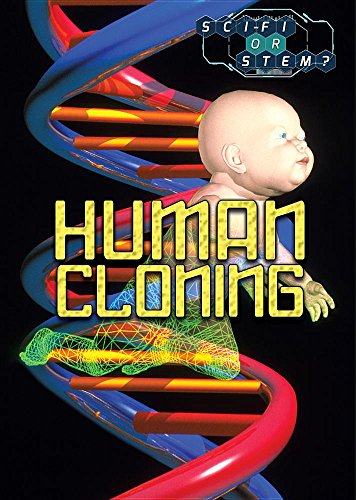-
Human Cloning
Kristi Lew
Library Binding (Rosen Young Adult, Aug. 15, 2018)As a genre, science fiction has the unique ability to inspire curiosity and deepen the understanding of issues that are facing STEM fields. One of those issues is the possibility of human cloning. This book examines how human cloning has been depicted in science fiction, the development of existing cloning technology, how scientists have used these techniques in the past, and their potential application for the future. Fascinated readers will explore topics such as somatic cell nuclear transfer (SCNT), animal cloning, and the ethical considerations surrounding therapeutic and reproductive cloning in humans. Z
Z
-
Human Cloning
Kristi Lew
Paperback (Rosen Young Adult, Aug. 15, 2018)As a genre, science fiction has the unique ability to inspire curiosity and deepen the understanding of issues that are facing STEM fields. One of those issues is the possibility of human cloning. This book examines how human cloning has been depicted in science fiction, the development of existing cloning technology, how scientists have used these techniques in the past, and their potential application for the future. Fascinated readers will explore topics such as somatic cell nuclear transfer (SCNT), animal cloning, and the ethical considerations surrounding therapeutic and reproductive cloning in humans. Z
Z
-
Cloning
Susan Henneberg
Paperback (Saddleback Educational Publishing, Sept. 1, 2015)Engage your most struggling readers in grades 3-6 with Red Rhino Nonfiction! This new series features high-interest topics in every content area. Visually appealing full-color photographs and illustrations, fun facts, and short chapters keep emerging readers focused. Written at a 1.5-1.9 readability level, these books include pre-reading comprehension questions and a 20-word glossary for comprehension support.Learn about the history, potential, and dangers of cloning, from the first cloned salamander to Dolly the sheep and beyond. S
S
-
Cloning
Susan Henneburg
eBook (Saddleback Educational Publishing, Sept. 1, 2015)Learn about the history, potential, and dangers of cloning, from the first cloned salamander to Dolly the sheep and beyond.Engage your most struggling readers in grades 3-8 with Red Rhino Nonfiction! This new series features high-interest topics in every content area. Visually appealing full-color photographs and illustrations, fun facts, and short chapters keep emerging readers focused. Written at a 1.5-1.9 readability level, these books include pre-reading comprehension questions and a 20-word glossary for comprehension support.
-
Cloning
Kara Rogers
Library Binding (Britannica Educational Pub, Aug. 30, 2015)Since the early 2th century, when Hans Spemann first twinned salamander embryos, scientists have made astounding progress in the science and technology of cloning. They have now developed the means to apply cloning in research, agriculture, and medicine. With advancements in cloning techniques for stem cell research, scientists have been able to explore human diseases at a cellular level, attempting to better understand the cellular mechanisms involved in disease. Readers explore the history, science, applications, and ethical issues of cloning. Sidebars profile pioneers in the field, including John Bertrand Gurdon, Ian Wilmut, Shinya Yamanaka, and James Thomson.
-
Cloning
Claire Owen
eBook (Independence Educational Publishers, April 1, 2008)Advances made in cloning and stem cell research could lead to new treatments for many illnesses, yet there are those who question the ethics of cloning. Where could cloning take us in the future and why does it remain such a controversial subject? This book looks at the developments that have been made and examines the debate surrounding this issue. The information comes from a variety of sources, including government reports and statistics, newspapers and magazine articles, surveys and polls, academic research and literature from charities and lobby groups; articles have been tailored to an 11 to 14 age group. Additionally, at the end of each chapter are two pages of activities relating to the articles and issues raised in that chapter.
-
Cloning
Jacqueline Langwith
Paperback (Greenhaven Press, May 11, 2012)Each title in the highly acclaimed Opposing Viewpoints series explores a specific issue by placing expert opinions in a unique pro/con format; the viewpoints are selected from a wide range of highly respected and often hard-to-find publications.; This addition to the popular Opposing Viewpoints series addresses the controversial topic of cloning. Through a balanced collection of articles from a variety of sources, the title explores the ethical and moral issues surrounding research cloning, the i; "Each volume in the Opposing Viewpoints Series could serve as a model…not only providing access to a wide diversity of opinions, but also stimulating readers to do further research for group discussion and individual interest. Both shrill and moderate, th
-
Cloning
Cathleen Small
Library Binding (Cavendish Square Publishing, Jan. 15, 2019)"A book for high school students about the history and developments made in the area of cloning"--
-
Cloning
Tina Kafka
Library Binding (Lucent Books, Dec. 14, 2007)Each title in this series presents a thorough and carefully balanced presentation of the many issues surrounding each topic, objectively exploring important political, social, cultural, economic, moral, historical, and environmental issues, and enabling students to gain a clear understanding of what affects them, their peers, and their community. Q
Q
-
Cloning
Jacqueline Langwith
Library Binding (Greenhaven Press, May 11, 2012)Each title in the highly acclaimed Opposing Viewpoints series explores a specific issue by placing expert opinions in a unique pro/con format; the viewpoints are selected from a wide range of highly respected and often hard-to-find publications.; This addition to the popular Opposing Viewpoints series addresses the controversial topic of cloning. Through a balanced collection of articles from a variety of sources, the title explores the ethical and moral issues surrounding research cloning, the i; "Each volume in the Opposing Viewpoints Series could serve as a model…not only providing access to a wide diversity of opinions, but also stimulating readers to do further research for group discussion and individual interest. Both shrill and moderate, th

